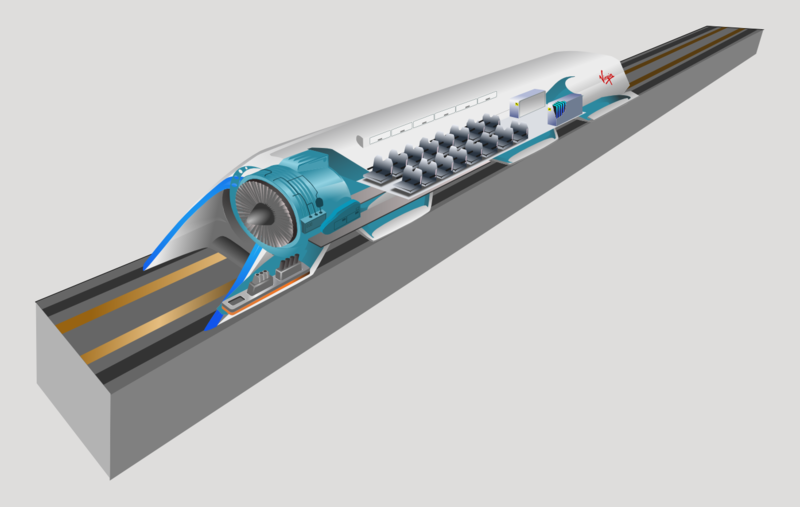Thoughts on Hyperloop
G'day Team
Steemstem is pushing for more community involvement so today I'll be responding to a seed post by @kryzsec regarding the science behind the Hyperloop concept.

Image Source - By Camilo Sanchez; CC Atribution-Share Alike
Disclaimer
But first... a disclaimer. This is a topic far outside my area of expertise! When I read someone posting about the benefits of superfoods, the harms of gluten and the dangers of GMOs, I can never keep my mouth shut. There's nothing more annoying than someone who's no idea what they're talking about trying to come off as an expert in a field you actually know something about.
Today I am that someone, but with a twist... I want to learn. I'll put forward some idea, but I hope to hear why they're misguided, stupid... or brilliant. Depends on what other people think or know!
So let's get started...
My Ideas on the Hyperloop
Problem A
The energy required to vacuum out a tunnel, accelerate a train, repressurize a tunnel for unloading of passengers and then again vacuum out a tunnel would appear to be a lot. In fact, more energy is used for the vacuuming process than is saved in reducing air resistance for a train traveling at high speed. In short, it would be more efficient to simply create bullet trains like Japan which are designed to travel very fast through the normal atmospheric air.
Solution A1
The problem here is constant pressurization and vacuuming... but this is only required when passengers embark and disembark. The solution is simple... no passengers!
Kidding! No, what we need is a way to open the interior of the carriages which are at normal atmospheric pressure directly to the external platform which is also at normal atmospheric pressure. So a smart mechanism involving magnetically sealed rubber seals could solve this problem!? A simple seal between each door on the train and a corresponding door in the platform would allow disembarkment without pressurization of the tunnel.
Complications A1
The problems that 'seals' create are that it only takes damage to or wearing down of one seal before it begins to leak and the whole system breaks down. So what's the life-expectancy of seals, what wear-and-tear can they withstand and what's their cost?
Solution A2
Don't want to rely on a lot of seals creating a safe passage between carriage and platform... all which have to be aligned perfectly each time the train stops, well maintained and perfectly installed... then maybe solution 2 is for you.
As the train pulls in to a platform the tunnel which it is in is sealed off at the front and back, creating a compartment within the tunnel in which the entire train is sealed. It's this compartment that is entirely repressurized when passengers embark and disembark. After this only that small section must be depressurized again once the train needs to get going.
This is efficient for a few reasons.
- Only a fraction of the entire tunnel must be depressurized, and it's an even smaller fraction than you'd think. Assuming the train takes up a considerable amount of the volume of the tunnel, only the remaining volume contains air which must be pumped out.
- If the depressurization isn't perfect, the remaining air in this small section will disperse out through the entire tunnel system once the seals at the front and back of the train come up to allow the train to keep moving again.
- Don't want to maintain seals at every door.... this system requires only two sealing mechanisms.
- Further improvements could be made... the snugger the fit of the train in the tunnel the more efficient the system.
Complications A2
We're still relying on seals and pumps... so we still have to calculate energy cost! Also it might take a lot of time to get these larger comparmentalizing seals up!
Problem B
A hyperloop train is theoretically more efficient because removal of pressure means there's no friction to resist acceleration and movement of a train... but what if there was another way to remove this friction?
Solution B1
Instead of removing air the tunnel system to decrease resistance to zero, could we perhaps move the air at the same speed as the trains?
A sealed tunnel system with an internal wind speed of 700km/hr (the same as our desired train speed) would have a few implications in my mind. A train in this system would not only have the benefit of having no wind resistance once it reached its top speed (relative velocity of two objects traveling in the same direction at 700km/hr being 0) but would also be actively pushed up to that speed by the wind in the tunnel.
There's also no need for depressurization and repressurization when the train stops to let passengers on or off.... simply have a small shield that protects the passengers from the winds in the tunnel!
Complications B1
I'm no engineer and no physicists... what's the energy cost of keeping a tunnel system running with an internal wind speed of 700kmph? What sort of resistance would be experienced on the walls of the tunnel? Would the wind erode the tunnel? Would the friction fry everyone inside? Would the wind simply bounce around and turn the whole system into a washing machine-style ride for anyone on a train?
I don't know! Tell me!
Solution B2
Is air as we know it the most efficient gas to travel through? Is there a more 'slippery' gas which we could fill a tunnel with, at a normal atmospheric pressure, to allow a train to travel through it without wasting energy on friction or pressure?
Complications B2
I have no idea about this one... it's an idea, but I don't know enough about gas laws or the physics of fluids to understand if this is a viable concept!?
Thanks
If you've made it to this point I hope I haven't made too much of an idiot of myself! Thanks for reading and I'm excited to read any comments or other discussion posts!
Thanks!
-tfc
steemstem

-tfc
Being A SteemStem Member
The energy to create a vacuum may be large but I guess that it would be amortized over a bunch of trips and/or years.
I am looking forward to Hyperloop's solution to the airlock problem.
I have a lot of issues with this machine.
I don't even know where to begin.
As an engineer, I wouldn't get on it.
@mrsomeone, would love to see your post on it
Would love to hear more! The seed post is here
There would be no wind in a tunnel if there is a vacuum and no erosion because of it.
Hey, thanks for the comment. I might not have made myself clear, I was proposing a tunnel with air in it moving at a speed of 700km/hr, instead of a vacuume to reduce resistance.
Oh, yes. That was part of problem B. Sorry.
Wow, I like it. You’re a genius @tfcoates (>‿♥)
Thanks very much :)
good job, thank you